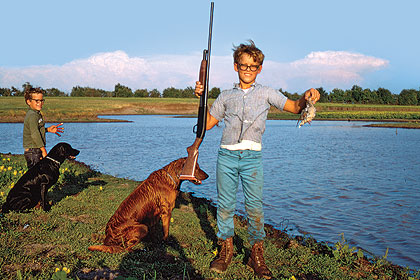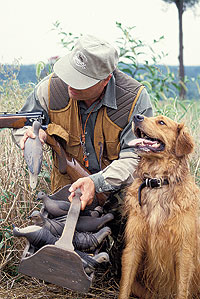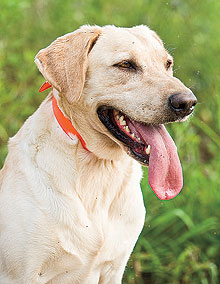These speedsters can provide a nice warm-up for duck season.
By James B. Spencer
Frankly, doves are not hunter-friendly. They frequently humble us by suddenly changing directions just as we pull the trigger. Their erratic flight patterns must stem from some rare avian neurosis.
 The author's son, Bob Spencer, many years ago with his first bird. Duffy, the Spencers' golden retriever, didn't see it fall, so it was a blind retrieve, a training fringe benefit during transitional dove hunting. |
Some statistician has claimed that only an accomplished wingshooter can consistently kill one dove for every six trigger-pulls. That's humbling. Since I'm at best a mediocre shotgunner, my average doesn't rise to this humbling level. No, mine's humiliating.
Then, too, dove meat is pricey. Not only do we miss them so often, but also each dove carries only a couple of edible morsels. Figuring only the cost of ammunition, we must conclude that dove meat costs more per pound than any other meat, shot or store-bought.
Granted, it's tasty, but not all that tasty.
Finally, the usually hot September weather favors neither man nor beast. It can be especially cruel to dogs. More on this later.
Sed Contra
But, on the other hand, dove hunting has a couple of practically irresistible advantages.
First, being our first annual hunting season, it catches us anxious to hunt anything.
Enough hunt tests! Enough field trials! Enough sporting clays! It's time to shoot something edible!
Further, by hunting doves we can guide our pooches through the transition from somewhat-artificial training to totally-real hunting before the seasons for our "major" birds arrive. This transition can benefit all sporting breeds in varying degrees. Each is an "and doves" breed, in that owners use every breed to fetch doves.
Once I even took a Kerry Blue terrier dove hunting. Never again. My wife and I spent four hours deburring those long, dense, curly locks.
But this transition is especially valuable for retrievers because we hunt doves very much like we hunt waterfowl. Ergo, in dove hunting, you can make your waterfowling pooch rock-steady, refresh his marking, accustom him to long waits between birds and sharpen up his handling on blind retrieves (real or set-up).
The Ideal Location
To maximize the transitional value of dove hunting, you should use a swimming-water pond. Because of the heat, you should set up on a well-shaded shore, if that's possible.
You need a hunting buddy along, preferably one who shoots his shotgun impressively well.
You also should have a couple of dummies, for reasons explained below. You should have your usual control equipment (strap-collar, lead, e-collar if he's collar-conditioned and so on). You need stools to sit on, and water to quench the thirst of both man and beast. You may take your shotgun along, but leave any mad compulsion to use it at home.
Step One
For your dog to make this transition effectively, you have to take him to dove hunts multiple times, some of which should be as close to the opening of duck season as possible.
 Pass-shooting doves away from water in hot weather puts a dog at risk of overheating. If possible, try to set up near a pond or stream and in the shade. |
During the first few sessions, leave the shooting to your buddy. Leave your shotgun in your vehicle or at home, if necessary. Your buddy should shoot while you concentrate on your dog.
Have your dog on lead and sitting at heel. When your buddy shoots, if the bird falls and your dog remains steady, send him to retrieve it. If he tries to break, or even creeps a little, correct and reposition him.
If your buddy can get the bird without swimming, let your buddy retrieve the bird. (Who said being a buddy was always easy? Buy his lunch or supper and he'll forgive you.) If your buddy can't get the bird without swimming, make your dog wait a long time, say 30 seconds, before sending him to retrieve.
If the bird doesn't fall, wonderful. You need plenty of these. If your dog breaks or creeps, correct him normally and wait for the next bird. If he doesn't break or creep, reward him by tossing a dummy for him to retrieve.
After your dog begins to remain steady without correction, remove the lead but be ready to correct him if he breaks, like with the e-collar if he's collar-conditioned. To keep your dog wet and to sharpen his handling, set up two blind retrieves each trip.
If your buddy also wants to take his dog through this process, you should hunt them one at a time. Because of the heat, the non-hunting dog should preferably stay at home.
Optionally, you might stake him out in a shady area with a bowl of drinking water a reasonable distance from the pond. Leaving a dog in a vehicle can be dangerous in September's heat — in fact, you just shouldn't do it.
Step Two
When your pooch remains steady consistently off-lead while your buddy shoots, you can break out your shotgun. But leave your shells in your vehicle, please. If you're the cautious type, put your pooch back on lead for a few birds. If you're a gambler, leave him off lead and, if he breaks, stop him however you like, such as with your e-collar.
When a dove comes within gun range, shoulder and point your shotgun, but don't get too caught up in what happens to the bird. No, watch your dog and leave the dove's fate to your buddy's shooting.
If your buddy misses and your dog remains steady, toss a dummy for him. If he breaks or creeps, correct him, bring him back beside you and wait for the next bird.
If your buddy hits the dove and your dog remains steady, wait a few seconds before sending him, just to remind him that your command and not the fall of a bird releases him to retrieve. If he breaks or creeps, correct him, bring him back and have your buddy pick up the bird.
 Watch closely for signs of overheating, like heavy panting, when hunting doves in warm weather with your dog. |
After he begins remaining steady without correction, take him off lead, but be ready to correct him if he breaks. Above all, continue watching your dog, not the bird, as you point your shotgun. The bird is your buddy's responsibility.
Throughout step two, if your buddy is taking his dog through this process, you should continue to work them one at a time, preferably leaving the non-working dog at home.
Step Three
When your dog remains steady consistently while you shoulder and point your shotgun, you can start loading and firing said shotgun — not every time, lest your inattentiveness tempt your pooch to fudge a little now and then, which could undo all your work to this point.
If your buddy is also training his dog, you should start bringing both dogs to the pond and taking turns shooting. Your dogs should share the retrieves, but in an unpredictable sequence: your dog once, your buddy's dog twice, your dog twice, your buddy's dog once, and so on.
When you aren't the shooter, forget about the bird and watch your dog. That takes willpower when you're just sure he won't break or creep. Yeah, sure.
After a few sessions like this, both your dogs are as ready as you can make them for waterfowling.
Beware of Heat
Dogs suffer from heat more quickly and more intensely than humans do. Humans stabilize their body temperature by sweating. Dogs can only pant, which just ain't all that efficient.
To prevent your dog from overheating during dove season, always hunt near water and keep him wet, if necessary, by tossing an occasional dummy into the drink for him to retrieve.
Every year during dove season, many dogs die from overheating.
This happens most frequently when walking doves up far from water, like along hedgerows. This may be a great way to get lots of shooting, but it puts dogs at grave risk.
I once almost lost a dog this way. I would have lost him if we hadn't been hunting close to a river. When he started wobbling from the heat, I carried him to the river and laid him down in the shallow water near shore. He lay there for perhaps 15 minutes before beginning to perk up.
After another 15 minutes, he wanted to start hunting again. No way! I heeled him to the car and drove home. No bird is worth a dog's life.
Pass shooting doves in waterless areas can also cause overheating. In fact, the only safe way to hunt doves with your dog in warm weather is to set up beside a pond, where you can keep him wet all day.
The progressive signs of overheating are heavy panting, the tongue hanging loosely out of the side of the mouth, wobbling around and falling down, which is quickly followed by death.
Remember: Only you can keep your dog from overheating. He would gladly die trying to please you.
Jim Spencer's books can be ordered from the Gun Dog Bookshelf: Training Retrievers for Marshes & Meadows; Retriever Training Tests; Retriever Training Drills for Marking; Retriever Training Drills for Blind Retrieves; Retriever Hunt Tests; HUP! Training Flushing Spaniels the American Way; and POINT! Training the All-Seasons Bird Dog.






